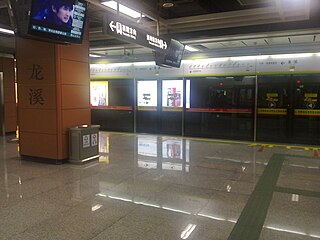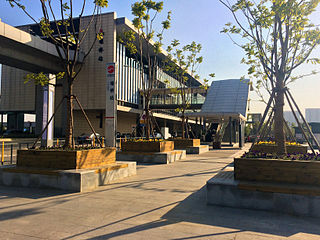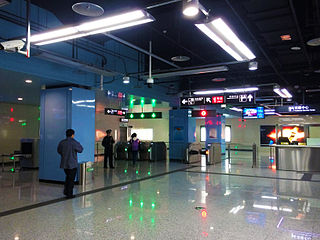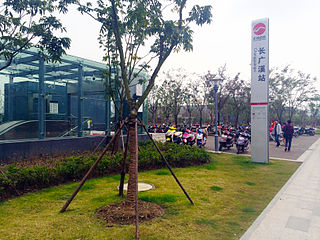
Hanxi Changlong Station is an interchange station on Line 3 and Line 7 of the Guangzhou Metro that started operation on 28 December 2006. It is located under the east side of Hanxi Avenue (汉溪大道), the Xinguang Expressway (新光快速公路), and the south of Chime-Long Paradise Amusement Park in the Dashi Subdistrict (zh) of the Panyu District of Guangzhou. There is a free shuttle bus connecting the station with the amusement park.

Tanwei Station, formerly Datansha South Station (大坦沙南站) and Datansha Station during planning, is an elevated station on Line 5 of the Guangzhou Metro and an underground station on Line 6. It is located at Zhongshuangqiao Park (中双桥公园) on Datansha Island in the Liwan District. It opened on 28 December 2009. It became an interchange station between Line 5 and Line 6 on 28 December 2013.
Haixinsha Island is an island in Haizhu District, Guangzhou, Guangdong, China. It is located between Luoxi Bridge and Xinguang Bridge. It is at the south of Lijiao Station of Haizhu Island and the north of Luoxi Island of Panyu District.

Longxi Station, formerly Huaboyuan Station (花博园站) during planning, is a metro station on Guangfo Line. It is located under Longxi Avenue (龙溪大道) in the Liwan District of Guangzhou, near the Guangzhou Luxin Garden (广州鲁新园艺场). It started operation on 3 November 2010.

Jingxi Nanfang Hospital Station is a metro station on Line 3 of the Guangzhou Metro. The underground station is located at Guangzhou Avenue North (广州大道北) near Nanfang Hospital (南方医院) in the Baiyun District. It started operation on 30 October 2010.

Pingzhou station is a station on Line 1 of the Shenzhen Metro in Shenzhen, Guangdong Province, China. The station opened on 15 June 2011.

Lingzhi station is a Metro station of Shenzhen Metro Line 5. It opened on 22 June 2011. This station is an underground station. Its Chinese name may have come from 灵芝.

Maigaoqiao station, is a station of Line 1 of the Nanjing Metro, and is the current northern terminus of the line. It started operations on 3 September 2005 as part of the line's Phase I from this station to Andemen.

Hedingqiao station, is a station of Line 1 of the Nanjing Metro. It began operations on 28 May 2010, as part of the southern extension of line 1 from Andemen to CPU.

Xi'anmen Station, formerly Yixianqiao station during planning until 2007, is a station of Line 2 of the Nanjing Metro. It is named after the former gate known as Xi'anmen of the Ming Palace, and started operations on 28 May 2010 along with the rest of Line 2.

Sanyang Plaza station, is an interchange station of Line 1 and Line 2 of the Wuxi Metro. It started operations on 1 July 2014. It is the largest metro station of China.

Yanqiao Station is a metro station on Line 1 of the Wuxi Metro. It began operations on 1 July 2014. The station is reserved for Xincheng Urban Line (锡澄市域轨道交通线) services towards Jiangyin.

Tanduqiao Station, is a metro station of Line 1, Wuxi Metro. It started operations on 1 July 2014.

Qingmingqiao Station, is a metro station of Line 1, Wuxi Metro. It started operations on 1 July 2014.

Huaqingdaqiao Station, is a metro station of Line 1, Wuxi Metro. It started operations on 1 July 2014.

Tangtieqiao Station, is a metro station of Line 1, Wuxi Metro. It started operations on 1 July 2014.

Changguangxi Station, is the eastern terminus of Line 1, Wuxi Metro. It started operations on 1 July 2014.

Dawangji Station, is a metro station of Line 2, Wuxi Metro. It started operations on 28 December 2014.

Zhuangqiao Station, is a metro station of Line 2, Wuxi Metro. It started operations on 28 December 2014.

Zhaqiao Station, is a metro station of Line 2, Wuxi Metro. It started operations on 28 December 2014. It will be the terminus of line 4.






















